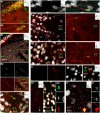New GABAergic interneurons in the adult neocortex and striatum are generated from different precursors
- PMID: 15684031
- PMCID: PMC2171716
- DOI: 10.1083/jcb.200407053
New GABAergic interneurons in the adult neocortex and striatum are generated from different precursors
Abstract
Ongoing neurogenesis in the adult mammalian dentate gyrus and olfactory bulb is generally accepted, but its existence in other adult brain regions is highly controversial. We labeled newly born cells in adult rats with the S-phase marker bromodeoxyuridine (BrdU) and used neuronal markers to characterize new cells at different time points after cell division. In the neocortex and striatum, we found BrdU-labeled cells that expressed each of the eight neuronal markers. Their size as well as staining for gamma-aminobutyric acid (GABA), glutamic acid decarboxylase 67, calretinin and/or calbindin, suggest that new neurons in both regions are GABAergic interneurons. BrdU and doublecortin-immunoreactive (BrdU+/DCX+) cells were seen within the striatum, suggesting migration of immature neurons from the subventricular zone. Surprisingly, no DCX+ cells were found within the neocortex. NG2 immunoreactivity in some new neocortical neurons suggested that they may instead be generated from the NG2+ precursors that reside within the cortex itself.
Figures







References
-
- Alonso, G. 2000. Prolonged corticosterone treatment of adult rats inhibits the proliferation of oligodendrocyte progenitors present throughout white and gray matter regions of the brain. Glia. 31:219–231. - PubMed
-
- Altman, J. 1962. Are new neurons formed in the brains of adult mammals? Science. 135:1127–1128. - PubMed
-
- Bedard, A., M. Cossette, M. Levesque, and A. Parent. 2002. Proliferating cells can differentiate into neurons in the striatum of normal adult monkey. Neurosci. Lett. 328:213–216. - PubMed
Publication types
MeSH terms
Substances
LinkOut - more resources
Full Text Sources
Other Literature Sources

